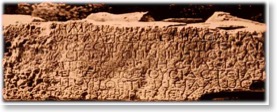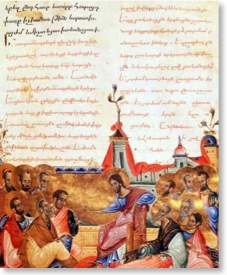He
dug a furrow through Knowledge and planted the
seeds of wisdom
St.
Nerses Shnorhali, on the legacy of Mesrob
Mashdotz
THE ARMENIAN ALPHABET
Since alphabets are the primary tools of
“fixing” a language, and given our present
knowledge of the evolution of letters since
their inception, we can only speculate about
the beginnings of hieroglyphic and cuneiform
scripts for keeping records of events, and
later, the transition into using one symbol for
each phonetic sound. We know very little about
the beginnings and the evolution of Phoenician,
Greek, Latin, or Aramaic characters, the
prototypes of most modern scripts and
languages.
The fixed/written aspect of a language is
unaffected by theories of linguistic evolution,
whether we accept the hypothetical theory of
the
wave
originating in central Europe and reaching
Armenia, based on the narrative of Greek
historians who tell the story of the
descendants of Jason and the Argonauts, the
Thraco-Phyrigian tribes giving their language
to the inhabitants of the indigenous people of
the Armenian plateau, or the theory of the
Proto Armenian language that evolved by
incorporating elements of other indigenous
languages (Hittite, Hurrite, Luwian, Akkadian,
Summerian) to pave the way for the Armenian
language.


By the turn of the 7th century BC, inhabitants of the Armenian plateau had ceased to use the cuneiform alphabet, which had been superseded by more flexible and functional alphabets, notably Aramaic (the official language by which Achaemenian Persia communicated with nearby peoples), which possessed its own script, as Greek had from the Hellenistic period.

In stark contrast, the creation of Armenian letters stands out as an illumination of at least one form of linguistic evolution. Not only the creation, but also the implementation of the Armenian alphabet on a relatively large scale for its time, remains a unique event in linguistic history. The creation of the alphabetical tools to “fix” Armenian is known in exceptional detail, including the circumstances of the birth of the letters and their subsequent impact on Armenian language and literature.

The official conversion of the Armenians to Christianity in the early years of the fourth century solidified an Armenian national identity despite the division of Armenian geographical territory between the Roman/Byzantine and Persian empires (387 AD). While the Armenian king Vramshabouh owed his crown to the non-Christian Persian king, the nobility--the king included--felt itself an integral part of the family of Orthodox Christians of the East (Byzantine) and South (Syriac).
Although Christianity was proclaimed the official religion of Armenians in 301 AD, the actual spread of the new religious doctrine was extremely slow. Sahag, the Catholigos, (head of the Armenian Church), had overseen a vast enterprise to confiscate and destroy the pagan temples and build new places of worship available to the population. Yet, complicating the difficult task of spreading the new faith was the way the Scriptures--written in Greek and Syriac--had to be interpreted for the population. Mesrob Mashdotz was keenly aware of this and laments the fact that “his brothers and kinsmen” could not be receptive to the message of salvation in their own language, Armenian.

A detailed account of the ensuing events is narrated by Gorune, a student of Mesrob Mashdotz and later a close collaborator, in Life of Mashdotz, written in the second half of the 5th century. This text is valuable historically even though many of its details remain speculative. It indicates the creation of the Armenian alphabet between 397 and 425 AD, with the year 401 seeming the most plausible. The form of the work is interesting in itself, representative of the sophistication of early Armenian texts. Life of Mashdotz is an encomium; a book of tribute rather than biography or history as we know it today. As a learned scholar at Samosata, and later, Constantinople, Gorune was familiar with the principals of encomiastic prose of Georgias of Leontini, Isocrates as well as the Ciceronian principles for composing encomia. Gorune’s Life of Mashdotz, however, takes a religious turn that would become a feature of future saints’ lives. In describing the return of Mashdotz to Armenia with the newly created alphabet, for example, Gorune writes, “even the magnificent Moses was not as happy when he descended from Mount Sinai.” In Gorune’s imagination the two events had real similarities. In Life of Mashdotz, on several occasions he refers to the Armenian letters as “Asdvadzadour,”--given by God. Divine intervention made the new letters of the Armenian alphabet appear in order to facilitate the translation of God’s words--the Bible--into Armenian. For Gorune and his contemporaries, this endeavor was primordial to the salvation of the Armenians.

Ultimately, the fifth century came to be known
as the Golden Age of Armenian
literature.